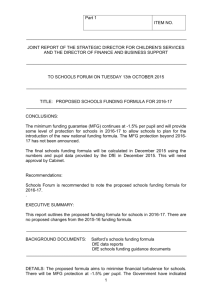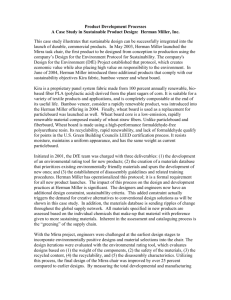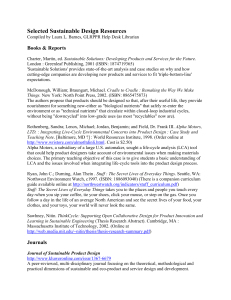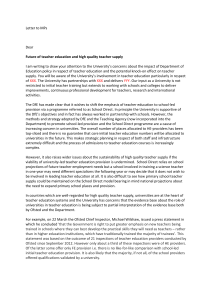Teaching Design for Environment in Product Design Classes Please share
advertisement
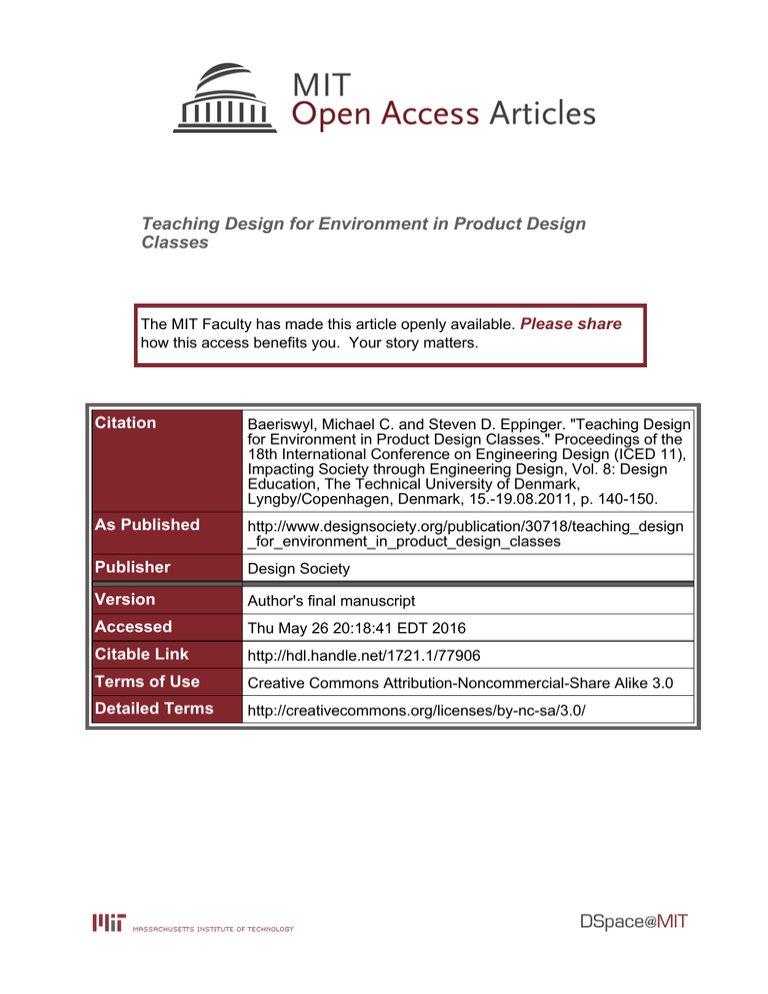
Teaching Design for Environment in Product Design Classes The MIT Faculty has made this article openly available. Please share how this access benefits you. Your story matters. Citation Baeriswyl, Michael C. and Steven D. Eppinger. "Teaching Design for Environment in Product Design Classes." Proceedings of the 18th International Conference on Engineering Design (ICED 11), Impacting Society through Engineering Design, Vol. 8: Design Education, The Technical University of Denmark, Lyngby/Copenhagen, Denmark, 15.-19.08.2011, p. 140-150. As Published http://www.designsociety.org/publication/30718/teaching_design _for_environment_in_product_design_classes Publisher Design Society Version Author's final manuscript Accessed Thu May 26 20:18:41 EDT 2016 Citable Link http://hdl.handle.net/1721.1/77906 Terms of Use Creative Commons Attribution-Noncommercial-Share Alike 3.0 Detailed Terms http://creativecommons.org/licenses/by-nc-sa/3.0/ INTERNATIONAL CONFERENCE ON ENGINEERING DESIGN, ICED11 15 - 18 AUGUST 2011, TECHNICAL UNIVERSITY OF DENMARK TEACHING DESIGN FOR ENVIRONMENT IN PRODUCT DESIGN CLASSES Michael C. Baeriswyl1 and Steven D. Eppinger2 (1) ETH Zurich (2) MIT Sloan School of Management ABSTRACT The paper presents an approach to teaching design for environment (DFE) in the context of a product design and development course. The teaching method has been applied in classes at the Massachusetts Institute of Technology for graduate engineering, business, and design students. Our approach includes a step-by-step DFE process and utilizes a recent Herman Miller chair as a case study to illustrate successful application of the process. The DFE process steps are based on our research at Herman Miller and on several published studies that investigated the integration of DFE into product development. We have found that the Herman Miller case study motivates students to learn a DFE process that enables progress towards sustainability based on design and several other business functions. Furthermore, the teaching method includes an extended approach to life cycle thinking by relating the product life cycle to the natural life cycle in order to from a closed-loop system. Keywords: design for environment, design education, product development process, life cycle thinking 1 INTRODUCTION During the last decade, the practice of design for environment (DFE) (also referred to as ecodesign or green design) has greatly expanded and gained importance [1]. This situation poses a challenge for teaching DFE. While the field itself has become increasingly complex and multidisciplinary, there is often not enough time to discuss and teach all relevant aspects related to engineering, materials, legislation and marketing within the limited time allocated to DFE in product design classes [2][3]. The Massachusetts Institute of Technology offers a project-based graduate course in product design and development, focusing on modern tools and methods, for students in engineering, business, and industrial design programs. Class sessions combine lecture and workshop modes and employ cases and hands-on exercises to reinforce the key ideas. The single session on DFE has evolved over a number of years and now encompasses three objectives: • Teach a practical step-by-step DFE process that fits the widely applied product development process articulated by Ulrich & Eppinger [4]. This DFE process includes activities throughout the product development process. It is based on recent literature on how to reduce or eliminate environmental impacts over the product life cycle and how to integrate DFE into the product development process. Unlike most DFE processes, our approach supports design teams in all design stages, even in the early stages when detailed data is not yet available. We provide qualitative assessments and practical design guidelines in the early stages and use more quantitative tools, such as life cycle assessment tools, in the later detailed design stages. • Illustrate the successful application of each step in the DFE process by utilizing a recent Herman Miller chair as a case study. The case study shows the students that company-wide progress towards sustainability is possible but depends on incremental progress in many departments of the company. • Teach the students an extended approach to life cycle thinking by relating the product life cycle to the natural life cycle in order to from a closed-loop system (Figure 1). This mode of thinking helps students to understand the complexity of the task and the need for a systematic and multidisciplinary approach [2]. This paper describes the DFE teaching method in the context of a product design and development course. The paper’s structure follows the composition of teaching method: First, we present the relevant aspects of the product life cycle and the natural life cycle. Second, we introduce the case ICED11 1 study about the Herman Miller Setu chair. Third, we explain the step-by-step DFE process and show how each step was applied in development of the chair. Fourth, we outline a set of student exercises that can be used to develop further insight. Finally, we conclude with some reflections on this teaching method. 2 AN EXTENDED APPROACH TO TEACHING LIFE CYCLE THINKING We created an extended life cycle diagram to teach students life cycle thinking as the basis of DFE. It helps to expand the traditional manufacturer’s concern with the production and distribution of its products to comprise a closed-loop system relating the product life cycle to the natural life cycle, both of which are illustrated in Figure 1. The product life cycle begins with the extraction and processing of raw materials from natural resources, followed by production, distribution, and use of the product. Finally, at the end of the product’s useful life there are several recovery options – remanufacturing or reuse of components, recycling of materials, or disposal through incineration or deposit in a landfill. The natural life cycle represents the growth and decay of organic materials in a continuous loop. The two life cycles intersect, as shown in the diagram, with the use of natural materials in industrial products and with the re-integration of organic materials back into the natural cycle. This way of thinking about materials in products has been called cradle-to-cradle thinking [5]. Figure 1. The natural life cycle and the product life cycle While most product life cycles take place over a few months or years, the natural cycle spans a wider range of time periods. Most organic materials (plant and animal based) can decay relatively quickly and become nutrients for new growth of similar materials. However, other natural materials (such as minerals), are created on a much longer time scale, and so are considered to be non-renewable natural resources. Therefore, depositing most mineral-based industrial materials into landfills does not readily re-create similar industrial materials for perhaps thousands of years (and often creating unnatural concentrations of certain harmful wastes). Each of the product life cycle stages may consume energy and other resources and may generate emissions and waste, all of which have environmental impacts. From this life cycle perspective, in order to reach conditions of environmental sustainability, the materials in products must be balanced in a sustainable, closed-loop system. This gives rise to three challenges of product design to reach sustainability, which are also represented in the life cycle diagram of Figure 1. • Eliminate use of non-renewable natural resources (including non-renewable sources of energy). • Eliminate disposal of synthetic and inorganic materials that do not decay quickly. • Eliminate creation of toxic wastes that are not part of natural life cycles. Organizations committed to DFE intend to work toward achieving these sustainability conditions over time. DFE helps these organizations to create better products by choosing materials carefully and by enabling proper recovery options so that the materials used in products can be reintegrated either into the product life cycle or into the natural life cycle. 2 ICED11 3 CASE STUDY: THE HERMAN MILLER SETU CHAIR A case study illustrating the successful application of each step in the DFE process comes from our field research at Herman Miller, Inc., a U.S.-based office furniture manufacturer. We selected Herman Miller due to their high commitment to DFE and due to our mutual understanding of a practical DFE process. In June 2009, Herman Miller, Inc., launched the Setu multipurpose chair, shown in Figure 2. The Setu (named after the Hindi word for bridge) aimed to set new standards of simplicity, adaptability, and comfort for multipurpose seating while being environmentally friendly. Herman Miller designed the Setu chair in collaboration with Studio 7.5, a design firm based in Germany. Multipurpose chairs, such as the Setu, are used where people sit for relatively short periods, such as conference rooms, temporary workstations, and collaborative spaces. (This is in contrast to a task chair in which the user sits for longer periods.) Studio 7.5 found that many chairs in office spaces where people spend from a few minutes to a few hours at a time were uncomfortable and misadjusted. Moreover, most office chairs are made with materials and processes that are harmful to the environment. Studio 7.5 recognized a market need for a new and innovative multipurpose chair – one combining comfort, design for environment, and a compelling price. The core of Setu is a flexible spine, molded of two polypropylene-based materials and engineered to achieve comfort for nearly everybody. As the user sits and reclines, the spine flexes, providing comfort and back support throughout the full range of tilt. Without any tilt mechanism and with only one adjustment (height), the chair is significantly lighter weight, less complex, and lower cost that its predecessors. Figure 2. Herman Miller launched the Setu chair in June 2009. The spine of the Setu chair is a combination of two polypropylene materials precisely engineered to flex and support as the user moves in the chair. (Courtesy of Herman Miller, Inc.) 4 PRESENTING A PRACTICAL DFE PROCESS We have found that the Herman Miller Setu chair case study motivates students to learn a step-bystep process that leads to effective DFE implementation. The entire DFE process can be illustrated with the Setu example as well. We based the DFE process on an extensive literature review of DFE research and methods. A large number of studies have investigated the problem of the integration of DFE into the product development process [6], [7], [8], [9], [10], [11], [12]. Our contribution is to assemble the lessons learned from these studies, as well as our experience with Herman Miller, into a step-by-step DFE process that has broad practical applications. Effective implementation of DFE includes activities throughout the product development process. The seven steps of the DFE process are shown in Figure 3. Despite the linear presentation of the steps, product development teams will likely repeat some steps several times, making DFE an iterative process. The following sections describe each step of the DFE process and how they were applied in the Herman Miller Setu case. Step 1: Set the DFE agenda: drivers, goals, and team The DFE process begins as early as the product-planning phase with setting the DFE agenda. This step consists of three activities: identifying the internal and external drivers of DFE, setting the ICED11 3 environmental goals for the product, and setting up the DFE team. By setting the DFE agenda, the organization identifies a clear and actionable path towards environmentally friendly product design. Identify the internal and external drivers of DFE The planning phase of DFE begins with a discussion of the reasons why the organization wishes to address the environmental performance of its products. It is useful to document both the internal drivers and the external drivers of DFE. This list may evolve over time, as changes in technology, regulation, experience, stakeholders, and competition each affect the capability and challenges of the organization. Internal drivers are the DFE objectives within the organization. Typical internal drivers of DFE are (adapted from [13]): product quality, public image, cost reduction, innovation, operational safety, employee motivation, ethical responsibility, and consumer behavior. External drivers of DFE typically include (from [13]): environmental legislation, market demand, competition, trade organizations, suppliers, and social pressures. Key DFE drivers for the Setu chair were market demand, innovation, and Herman Miller’s commitment to environmental responsibility. Studio 7.5 and Herman Miller developed the early Setu concepts with these drivers in mind. Figure 3. The DFE process involves activities throughout the product development process. Set the DFE goals An important activity in the product-planning phase is to set the environmental goals for each product development project. Many organizations have established a strategy that includes longterm environmental goals. These goals define how the organization complies with environmental regulations and how the organization reduces the environmental impact of its products, services, and operations. In 2005, Herman Miller set its long-term environmental goals for the year 2020: zero landfill, zero hazardous waste generation, zero harmful air emissions, zero process water use, all green electrical energy use, all buildings certified to meet environmental efficiency standards, and all sales from products created with the DFE process. To achieve the long-term goals, specific environmental goals may be set for every product during the planning phase. These product-level goals also allow the organization to make progress toward its long-term strategy. Based on an understanding of which life cycle stages contribute significant environmental impacts, goals may be developed accordingly. Herman Miller understands that the primary environmental impacts of their office furniture products are in the materials, production, and 4 ICED11 recovery stages. For the Setu chair, Herman Miller aimed to use exclusively materials with low environmental impact, facilitate product disassembly, and enable recycling. Set up the DFE team DFE requires participation by many functional experts on the product development project. The typical composition of a DFE team (often a sub-team within the overall project team) consists of a DFE leader, an environmental chemistry and materials expert, a manufacturing engineer, and a representative from the purchasing and supply chain organization. Of course, the DFE team composition depends on the organization and needs of the specific project, and may also include marketing professionals, outside consultants, suppliers, or other experts. Herman Miller first formed their DFE team in 1999 to work with the designers and engineers on every product development project to review material chemistry, disassembly, recyclability, incoming and outgoing packaging, energy sources and uses, and waste generation. The DFE team is involved as early as possible to ensure that DFE considerations are taken into account right from the start. By working closely with each product development team, the DFE team provides the tools and knowledge for making environmentally sound design decisions. Step 2: Identify potential environmental impacts Within the concept development phase, DFE begins by identifying the potential environmental impacts of the product over its life cycle. This enables the product development team to consider environmental impacts at the concept stage even though little or no specific data (regarding material and energy use, emissions, and waste generation) are yet available for the actual product and a detailed environmental impact assessment is not yet possible. In the most cases, however, relevant data may be provided by impact analysis of some existing products. (See life cycle assessment methods in Step 5 below.) Figure 4 shows a chart that can be used to qualitatively represent the environmental impacts over the product’s life cycle. To create this chart, the team asks, “What are the significant sources of potential environmental impact in each life cycle stage?” The team lists for each life cycle stage the anticipated key environmental impacts. The height of each bar in the chart represents the team’s judgment about the overall magnitude of the potential environmental impacts and therefore where to focus their DFE efforts. For some products (e.g. automobiles, electronic devices) the most significant impacts are found to be in the use stage. For other products (e.g. clothing, office furniture) the greatest impacts may be in the materials, production, and recovery stages. Figure 4 shows a qualitative life cycle assessment for office furniture in general. This understanding guided DFE in the Setu chair project. Figure 4. The qualitative life cycle assessment represents the team’s estimate of the potential types and magnitudes of environmental impact of the product over its life cycle. This chart depicts the types of impact most relevant to office furniture products such as the Setu chair. ICED11 5 Step 3: Select DFE guidelines Guidelines help product design teams to make early DFE decisions without the type of detailed environmental impact analysis that is only possible after the design is more fully specified. Relevant guidelines may be selected based in part on the qualitative assessment of life cycle impacts (from Step 2). Selecting relevant guidelines during the concept development phase allows the product development team to apply them throughout the product development project. Table 1 shows a compilation of DFE guidelines based on a study by Telenko, et al., [14]. Each life cycle stage has its own DFE guidelines that provide product development teams with instructions on how to reduce the environmental impact of a product. Many of the guidelines relate to selection of materials. This underscores the central role of materials in DFE. For the Setu project, the DFE experts provided the product development team with several guidelines. These guidelines are identified with * in Table 1. Table 1. A selection of some DFE guidelines arranged according to the life cycle stage of a product, based on Telenko [14]. Guidelines used in the Setu project are identified with *. Life Cycle Stage Design for Environment Guidelines Sustainability of resources Materials Healthy inputs and outputs Production Minimal use of resources in production Distribution Minimal use of resources in distribution Efficiency of resources during use Use Appropriate durability Recovery Disassembly, separation, and purification - Specify renewable and abundant resources*. - Specify recyclable, or recycled materials*. - Specify renewable forms of energy*. - Specify non-hazardous materials*. - Install protection against release of pollutants and hazardous substances. - Include labels and instructions for safe handling of toxic materials*. - Employ as few manufacturing steps as possible*. - Specify materials that do not require surface treatment or coatings*. - Minimize the number of components*. - Specify lightweight materials and components*. - Minimize packaging. - Use recyclable and/or reusable packaging materials. - Employ folding, nesting, or disassembly to distribute products in a compact state. - Apply structural techniques and materials to minimize to total volume of material. - Implement default power down for subsystems that are not in use. - Use feedback mechanisms to indicate how much energy or water are being consumed. - Implement intuitive controls for resource-saving features. - Consider aesthetics and functionality to ensure the aesthetic life is equal to the technical life. - Facilitate repair and upgrading. - Ensure minimal maintenance. - Minimize failure modes. - Ensure that joints and fasteners are easily accessible*. - Specify joints and fasteners so that they are separable by hand or with common tools*. - Ensure that incompatible materials are easily separated*. Step 4: Apply the DFE guidelines to the initial product design As the product architecture is developed during the system-level design phase, some initial material choices are made along with some of the module design decisions. It is beneficial, therefore, to apply the relevant DFE guidelines (selected in Step 3) at this point. In this way, the initial product design may have lower environmental impact. The Setu team wanted the chair to be lightweight in order to reduce materials use and transportation impacts (application of the DFE guideline: Specify 6 ICED11 lightweight materials and components). They achieved this by developing a concept and product architecture that avoided an under-seat tilt mechanism and other complexities. This helped to reduced the chair’s weight by as much as 20 pounds (9 kg). The Setu team also looked for new ways to ease the disassembly of the Setu in order to facilitate recycling. They placed each joint where it is easily accessible and also ensured that Setu’s components are separable by hand or with common tools (application of the DFE guidelines: Ensure that joints and fasteners are easily accessible; Specify joints and fasteners so that they are separable by hand or with common tools). In the detailed design phase, the exact materials specifications, detailed geometry, and manufacturing processes are determined. Application of the DFE guidelines in detail design is essentially the same as in system-level design, however, at this point many more decisions are being made and environmental factors can be considered with greater precision. By specifying low-impact materials and reducing energy consumption, product development teams create more environmentally friendly products. Furthermore, the DFE guidelines may inspire product development teams to come up with improvement in the functionality and durability of the product, which may lead to significantly lower environmental impacts. Studio 7.5 designers prototyped many iterations of the Setu spine in order to achieve proper support and recline. Once the shape of the spine was set, the team had to find materials that suited both the functional and environmental requirements. To specify materials that fit the environmental and functional requirements, the development team used Herman Miller‘s proprietary material database. The database, maintained together with consultants from McDonough Braungart Design Chemistry (MBDC), considers the safety and environmental impact of each material and classifies them into one of four categories: green (little to no hazard), yellow (low to moderate hazard), orange (incomplete data), and red (high hazard). Herman Miller’s aim was to use only materials that rank yellow or green for all new products. For example, polyvinyl chloride (PVC) is classified as a red material. PVC is a polymer that is commonly used in furniture and other products due to its low cost and high strength. However, both the production and the incineration of PVC releases toxic emissions. To avoid using materials that are toxic to humans and the environment (application of the DFE guideline: Specify non-hazardous materials), the engineers specified safer materials such as polypropylene and avoided PVC entirely. Step 5: Assess the environmental impacts The next step is to assess, to the extent possible, the environmental impacts of the product over its entire life cycle. To do so with precision requires a detailed understanding of how the product is to be produced, distributed, used over its lifetime, and recycled or disposed at the end of its useful life. This assessment is generally done on the basis of the detailed bill of materials (BOM), including sources of energy, component material specifications, suppliers, transportation modes, waste streams, recycling methods, and disposal means. Several quantitative life cycle assessment (LCA) tools are available to conduct such an environmental assessment. These tools range in price and complexity and would be selected based on the types of materials and processes involved, and the precision required of the analysis. LCA requires a significant amount of time, training, and data. Many LCA analyses are comparative and provide a basis for considering the environmental performance of product design alternatives. Commercial LCA software is becoming widely used in product design and supporting data are available for common materials, production processes, transport methods, energy generation processes, and disposal scenarios. Herman Miller uses their own proprietary DFE assessment tool, developed for them by MBDC. The DFE tool consists of a spreadsheet interface and the materials database using the color coding described above. The tool considers four factors for each component in the product: • Material chemistry - fraction of the materials by weight that are the safest possible in terms of human toxicity and environmental concerns • Recycled content - fraction of the materials by weight that are post-industrial or post-consumer recycled content • Disassembly - fraction of the materials by weight that can be readily disassembled • Recyclability - fraction of the materials by weight that are recyclable ICED11 7 Once the initial Setu design was established, the chair was divided into modules, with different teams assigned to develop each module. As each team designed their module, the DFE team assessed the design using the DFE tool. Compare the environmental impacts to DFE goals This step compares the environmental impacts of the evolving design to the DFE goals established in the planning phase. If several design options were created in the detail design phase, they may now be compared to judge which one has the lowest environmental impacts. Unless the product development team is very experienced in DFE, the design will generally have much room for improvement. Usually several DFE iterations are required before the team is satisfied that the product is as good as it should be from a DFE perspective. Step 6: Refine the product design to reduce or eliminate the environmental impacts The objective of this step and subsequent DFE iterations is to reduce or eliminate any significant environmental impacts through redesign. The process repeats until the environmental impacts have been reduced to an acceptable level and the environmental performance fits the DFE goals. Redesign for ongoing improvement of DFE may also continue after production begins. After several design iterations, the Setu team developed a way to co-mold the spine using two different polypropylene materials, which are compatible for recycling without separation. The inner and outer rails of the spine are made of a polypropylene-and-glass composite, while the connecting spokes are molded using a more flexible polypropylene-and-rubber composite (see Figure 5). Setu’s aluminum base is an example of “minimal design”. Uncoated and unpolished, with no finishing labor and no harmful toxins, it is durable and has less environmental impact than traditionally finished chair bases. One of the difficult trade-offs addressed in development of Setu related to selection of materials for the arms of the chair. While they were determined to avoid using PVC, the team was not able to mold the arms using all olefinic materials (such as polypropylene) due to concerns of durability and fatigue failure. The Setu arms, therefore, were molded from nylon and over-molded with a thermoplastic elastomer. Since these materials are not chemically compatible for recycling, this decision limited the chair’s overall recyclability. Figure 5. The design of the Setu spine (left) and aluminum base (right). (Courtesy of Herman Miller, Inc.) Step 7: Reflect on the DFE process and results As with every aspect of the product development process, the final activity is to ask: • How well did we execute the DFE process? • How can our DFE process be improved? • What DFE improvements can be made on derivative and future products? Based on Herman Miller’s DFE assessment tool, on a scale of 0 to 100%, with 100% being a truly “cradle-to-cradle” product, the Setu chair achieved a rating of 72%, as shown in Table 2. The Setu team was pleased with the chair in terms of ease of disassembly and feasibility of recycling. Over the course of developing the Setu, the chair’s recyclability score moved up and down and eventually dropped from 99% to 92% due to the material selection trade-off in design of the arms. One very important achievement made during the development of the Setu to enable its recyclability was a change in the spine’s materials. Early iterations used dissimilar materials bonded together, which 8 ICED11 could not be recycled. The DFE team challenged the Setu team to innovate further. The resulting solution is constructed of two materials that are compatible for recycling without separation. Unfortunately, such a solution could not be developed for the Setu arms, and incompatible bonded materials were used there. While highly successful in terms of implementing DFE, the Setu chair still had some negative environmental impacts, particularly in terms of material chemistry and use of recycled content, as shown in Table 2. This reflects the reality that creating a perfect product from a DFE perspective is a goal that may take years to achieve. Effective DFE requires a product development organization that strives for continuous improvement. The DFE team may be able to further develop the Setu chair to reduce some of the known impacts. For example, molding the Setu arms entirely using polypropylene would likely improve recyclability and reduce cost, but would also require addressing several very challenging technical issues. Table 2. Herman Miller’s DFE assessment tool considers four factors and computes a weighted overall score of 72% for the Setu chair. DFE Assessment Factor Material Chemistry Recycled Content Disassembly Recyclability Overall Score Setu Score 50% 44% 86% 92% Factor Weight 33.3% 8.4% 33.3% 25% 100% Weighted Score 16.7% 3.7% 28.6% 23% 72% To further improve their DFE process, Herman Miller began to use LCA software to monitor their DFE results and to guide further refinement of their products. They next planned to integrate “carbon footprint” into their DFE tool. The carbon footprint of a product is the amount of greenhouse gas emissions caused by the product, usually expressed in terms of the equivalent mass of CO2 emitted. The consideration of carbon footprint would further affect Herman Miller’s material choices. For example, based only on recyclability and environmental toxicity, aluminum is an environmentally friendly material. However, considering the carbon footprint of aluminum, it may be a less favorable choice (compared to steel, for example) due to the amount of energy required to produce new aluminum. Recycled aluminum, however, uses much less energy, so this analysis also depends upon the sources of the materials and energy used to process the metals. 5 STUDENT EXERCISES Many design courses offer students the opportunity to apply the DFE process directly in a project setting. We have found this to be a highly effective learning approach. In addition, we have developed several exercises and discussion questions to allow students to apply life cycle thinking. Here are several such challenges for design students. 1. What are some of the ways in which you have become more aware of your own environmental impact in recent years? 2. List at least 10 types of environmental impact over the life cycle of your personal computer or mobile phone. Chart these as in Figure 4, representing your judgment of the relative impact of each life cycle stage. For the Setu chair, what types of environmental impact would be in the use stage of its life cycle? 3. In what ways can DFE help to improve the quality of a product, in terms of its functionality, reliability, durability, and reparability? 4. For each life cycle stage, identify a product or service that has high environmental impacts during the particular life cycle stage. Then, suggest a new or existing product or service that provides the same functionality with lower (or without any) environmental impacts. 5. Explain the relationship between DFE and design for manufacturing. Consider, for example, those DFE guidelines related to production in Table 1. 6. How would you explicitly include renewable and non-renewable energy in the life cycle diagram in Figure 1? Draw such a diagram and explain it. 7. Consider the DFE assessment tool used by Herman Miller (Table 2), which computed the weighted sum of scores for material chemistry, use of recycled content, ease of disassembly, and recyclability. What modifications would you propose to create a DFE assessment tool for a ICED11 9 different type of product, such as an automobile or a mobile phone. 6 CONCLUSIONS Many recent approaches to DFE have been based primarily on detailed life cycle assessment tools. The method presented here does not rely on LCA from the start. Instead, the DFE method follows the product development process from the early strategic planning and conceptual stages through detailed design. In the early stages, qualitative assessments and practical design guidelines can be used to create designs with reduced environmental impact. In the later detailed design stages, more quantitative tools can be applied to further reduce impact. We have described the DFE method and how we teach it using the Herman Miller Setu chair case study to illustrate its successful application. ACKNOWLEDGMENTS This paper is based upon a new chapter we have written for the forthcoming 5th edition of the Product Design and Development textbook [4]. We wish to acknowledge the contributions of Herman Miller in development of the Setu chair case study used to illustrate the DFE process. REFERENCES [1] Boks C. and McAloone T. Successive Transitions in Ecodesign: From the Stopwatch Era to Technology Transfer and Commercialization. In Proceedings of the 15th CIRP International Conference on Life Cycle Engineering, 17-19 March 2008, Sydney, Australia, pp. 118-123. [2] Boks C. and McAloone T. The Design of Eco Board Games as a deep-learning approach to sustainable product design education. In Proceedings of the 11th International Conference on Engineering and Product Design, 10-11 September 2009, Brighton, UK. [3] Ion W.J., Stone A., Grierson H., Juster N. and Wodehouse A. A Study of Student Learning in Design Projects. International Engineering and Product Design Education Conference, 2-3 September 2004, Delft, Netherlands. [4] Ulrich K.T. and Eppinger S.D. Product Design and Development, 5th edition, 2012 (McGrawHill, New York). [5] McDonough W. and Braungart M. Cradle to Cradle: Remaking the Way We Make Things, 2002 (North Point Press, New York). [6] McAloone T., Mougaard K., Restrepo J. and Knudsen S. Eco-Innovation in the Value Chain. In Proceedings of the International Design Conference, 2010, Dubrovnik, Croatia. [7] Bhamra T.A., Evans S., McAloone T.C., Simon M., Poole S. and Sweatman A. Integrating Environmental Decisions into the Product Development Process. In Proceedings of EcoDesign '99: First International Symposium On Environmentally Conscious Design and Inverse Manufacturing,1999. [8] Fargnoli M. An Integrated Approach for the Development and Management of Environmentally Conscious Products. Environmentally Conscious Design and Inverse Manufacturing, 2005, pp. 361-367. [9] Ernzer M., Gruner C. and Birkhofer H. Implementation of DFE in the Daily Design Work - An Approach derived from Surveys. In Proceedings of DETC 2002 ASME Design Engineering Technical Conference, 29 September-2 October 2002, Montreal, Canada. [10] Dewulf W. and Duflou J. Integrating Eco-Design Into Business Environments: A multi-level approach. Product Engineering, 2005, pp. 55-76. [11] Wimmer W. and Züst R. Ecodesign Implementation: A systematic Guidance on Integrating Environmental Considerations into Product Development, 2004 (Alliance for Global Sustainability). [12] Enzer M. and Wimmer W. From Environmental Assessment Results to Design for Environment Product Changes: An Evaluation of quantitative and qualitative Methods. Journal of Engineering Design, 2002, 13(3), pp. 233-242. [13] Brezet H. and van Hemel C. Ecodesign: A promising Approach to Sustainable Production and Consumption, 1997 (TU Delft, Netherlands). [14] Telenko C., Seepersad C.C. and Webber M.E. A Compilation of Design for Environment Principles and Guidelines. In Proceedings of IDETC/CIE, 2008, New York, USA. 10 ICED11 Contact: Michael C. Baeriswyl ETH Zurich Department of Management, Technology, and Economics Scheuchzerstrasse 7, SEC E2 8092 Zurich, CH +41 44 633 92 47 mbaeriswyl@ethz.ch Steven D. Eppinger Massachusetts Institute of Technology Sloan School of Management Room E62-468 Cambridge, MA 02142 USA +1 617-253-0468 eppinger@mit.edu Michael is a PhD candidate and senior researcher at the Bits to Energy Lab at ETH Zurich. Steven is a professor of management, innovation, and Engineering systems at Massachusetts Institute of Technology. ICED11 11
